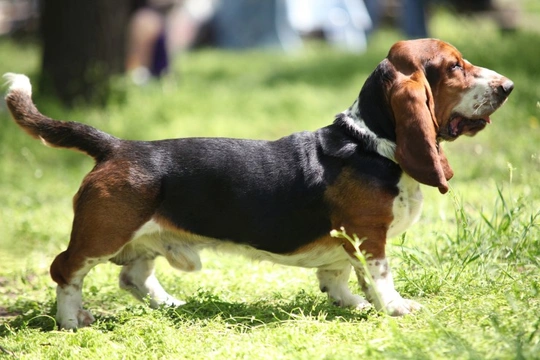
How to keep your Basset hound’s coat and skin clean and healthy
Basset hounds are very easy to recognise thanks to a combination of their core traits, all of which are very distinctive in their own rights. Basset hounds have a form of canine achondroplasia or dwarfism, which causes them to have particularly short legs topped off with a large body and head. They also have very long, drooping ears and of course, huge, soulful eyes and long jowls.
However, one Basset hound feature that doesn’t get as much attention as it perhaps should is the Basset hound coat – which is short and single layered, a coat type that we tend to think of as being very low maintenance and easy to care for. Whilst this is certainly true to an extent because a short coat is less likely to form into matting or get knotted and tangled up, Bassets have a number of unique traits to their coat type and texture, which means that they need some special care and attention.
Basset hounds tend to have quite oily coats and skin, which is something that was useful to them in their historical working roles, providing protection from the elements, helping to waterproof the coat, and promoting healthy skin. Keeping on top of your Basset hound’s coat and keeping it clean and healthy without stripping the coat of the natural oils it needs can be a challenge, and so in this article we will share some tips on how to keep your Basset hound’s coat and skin healthy. Read on to learn more.
More about the Basset hound coat and skin
Basset hounds have coats that should be smooth and short, lying in one direction close to the skin. The coat itself is single layered without feathering, being quite uniform in length, and should have a firm texture that is neither too harsh nor too fine.
Dogs of the breed have loose skin that forms into wrinkles, which can cause rubbing within the creases if these are not kept clean and dry, and their skin should always be elastic and supple. Basset hounds produce quite a lot of skin oil, helping to lubricate the breed’s loose skin and provide an additional barrier to protect it against dirt and debris. This means that the Basset coat may feel quite oily too, but because the dogs are short haired, this won’t generally be overly pronounced.
Keeping the Basset hound’s skin clean and healthy means that you need to work with this natural oiliness, rather than seeking to strip it or dry the skin out, which can interfere with the skin’s natural protective bacteria, affecting both coat and skin in its turn. However, this high level of oil production can mean that Bassets get dirtier faster than other dogs, because they are both low to the ground and oil tends to attract and catch dirt and muck.
Grooming and checking the coat and skin
Many people think that Bassets don’t need brushing and grooming because they have short coats, but this is something that all dogs, including Bassets, can benefit from.
Basset hounds also shed a moderate amount of fur year-round, and so brushing them can help to remove shed hair, which will often lie loose within the coat (assisted by the breed’s oily skin) and congest it, which can make your dog smell bad and also make them more prone to getting skin irritations and sore spots.
Brushing your dog for a few minutes a couple of times a week (or more often if required) can help to boost the circulation in your dog’s skin, remove shed hair, and distribute the natural skin oils along the length of the coat. It also helps to remove excess oil, and dirty patches.
Use a short, soft brush to do this, and go over the whole of your dog’s body and not just their back and flanks.
When you brush your dog, check them over for any signs of problems like parasites, spots, sores or other issues like congestion, rashes or inflammation.
Baths and regular maintenance
All dogs need to be bathed now and again to keep them smelling sweet and keep their coat and skin clean and healthy, and Basset hounds are no exception. Rather than bathing your dog on a fixed schedule, get to know their coat and skin so that you can tell when they need a bath and plan accordingly, to avoid the risk of bathing your dog too much and upsetting their skin’s natural balance.
This is important even if your Basset has a very oily coat, as bathing too often can actually cause the skin to produce more oil if it feels dry and uncomfortable.
When you bathe your Basset hound, it is important to choose a mild, gentle shampoo that is designed for dogs, and not one that is overly strong or harsh. As well as thoroughly cleaning your dog’s fur and skin, you must also ensure that you rinse every last trace of shampoo away, and dry your dog thoroughly – including within their wrinkles and skin folds.
Getting to know your dog over time with regular baths and grooming will allow you to get used to the normal feel and texture of your dog’s coat, and how oily their skin is – so that you can spot any changes or potential problems that might signal the need for a change in their care.



